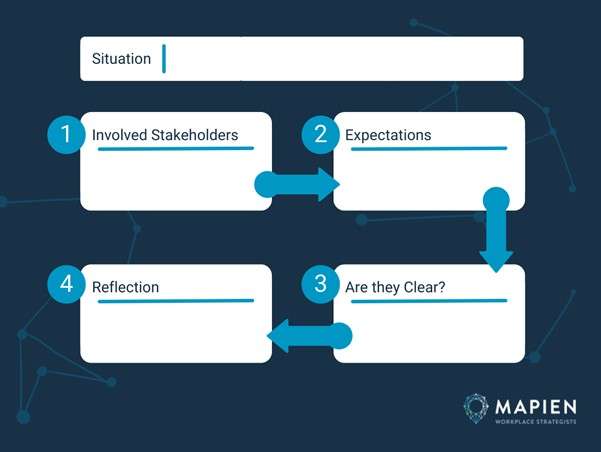
Stealth Expectations and the Importance of Shared Understanding
This is blog #7 in our series on coaching models. Sign up to our mailing list to make sure you don’t miss out on our future content.
Ever found yourself getting caught up in feelings of disappointment and resentment towards others in your workplace? Or feel like the people within your circle continually miss the mark?
Maybe it’s a skills and development gap, but a more likely explanation is that you’ve been operating in stealth mode without realising it. And that the real missing piece of the puzzle isn’t scheduling a bunch of team training, but developing a shared understanding.
It’s time you were introduced to the concept of stealth expectations…
What are Stealth Expectations?
A stealth expectation is something that you (or the people around you) expect from others, but are not consciously aware of. It’s an imagined reality or outcome – something that you anticipate, predict, believe, or hope will happen.
People tend to develop stealth expectations of themselves and of others, based on their previous experiences, their knowledge, or their own personal wants and needs.
Why Stealth Expectations Matter
“Stealth expectations and disappointment have been the sources of some of our most difficult arguments and hurt feelings.”
– Brene Brown
Stealth expectations influence your thoughts, feelings, and behaviours — and these will impact your interactions with others, your actions, and your environment. The tricky part is that you may not realise where these thoughts, feelings, and behaviours are coming from unless you pay very close attention.
On top of this, not meeting stealth expectations can lead to some negative side effects:
- When you fall short of your own stealth expectations – You may develop feelings of shame, unworthiness, and negativity towards yourself
- When the people around you don’t meet your stealth expectations – You’ll likely feel disappointed, resentful, frustrated, and even bitter
- When you don’t meet someone else’s expectation of you (that you were not aware of) – They may feel and act upon their feelings of frustration and disappointment towards you
Steal expectations are a quick way to ruin your own day, entirely by accident. But the good news is that with a little self-reflection, you can take control of them and get back on course!
Why Leaders Must Unpack Stealth Expectations

It’s normal to have expectations — it’s part of being a human! In fact, studies have found that social expectations are rooted in the natural human drive for reciprocity. And it’s normal for different people to have different expectations, because we all have unique backgrounds, perspectives, beliefs, and experiences.
But stealth expectations can very quickly become an issue for people, and especially for leaders.
They can lead to:
- Lower motivation, productivity, and performance
- Negative workplace interactions
- Disconnected teams
- Difficulty agreeing on what makes something a success or failure
- Difficulty identifying expected outcomes or a way forward in projects
To sum it up, stealth expectations create barriers to developing the kind of shared understanding that enables effective teams. And as a leader, it’s important to develop a conscious awareness of your own expectations (and the expectations of those you work with) so that you can manage them and lead more effectively.
4 Steps Towards Shared Understanding

The key to managing stealth expectations is first becoming aware of them — and then making other people aware of them. Here’s a process you can follow to discover and break down your own expectations:
Step 1: Who’s Involved?
First, consider a situation or task in which you’re having difficulty and would like to improve the way you work with others. Note down any other people or stakeholders involved in the task or situation.
Here are a few example situations that might come up as a leader:
Situation 1: Monday morning meetings — difficulty with attendance and participation from team members.
Involved Stakeholders:
- Marketing Director
- Sales Director
- Chief Financial Officer
- Executive Assistant
2: Workplace inclusivity — difficulty with reaching target numbers and feedback survey suggests this could be better.
Involved Stakeholders:
- Human Resources Team
- Hiring Managers
- All other staff in decision-making positions
3: Meeting deadlines — difficulty with team meeting deadlines to deliver the new software product.
Involved Stakeholders:
- Project Manager
- Product Owner
- Developers
- Designers & UX
- Quality Assurance
- Legal
- Marketing
Step 2: What Are the Expectations?
Now it’s time to identify what your expectations are in the situation you noted. You may have one expectation that applies to all the involved stakeholders, or you may expect different things from different people. To help identify all your expectations, imagine your stakeholders showed up in the situation and did nothing — then note down everything they should be doing instead.
For example, let’s break down what your expectations might be for the example in step 1 where attendees are struggling to attend and participate in Monday morning meetings.
| Involved Stakeholders | Expectations |
|
Marketing Director |
|
|
Sales Director |
|
|
Chief Financial Officer |
|
|
Executive Assistant |
|
Step 3: Is It a Stealth Expectation?
Reflect on the expectations you recorded in step 2.
Ask yourself…
- Was this expectation developed through a shared understanding (rather than my own personal and private interpretation of what should happen)?
- Was this expectation clearly communicated to others?
- Have others confirmed they correctly understood my expectations?
- Have I confirmed with others that their understanding is correct?
If you answered no to any of these questions, it’s likely that you’re dealing with a stealth expectation.
To continue our example, we may discover that it was never communicated that three of the four stakeholders should arrive before the meeting is scheduled to begin. We may also realise that although both the Marketing Director and Sales Director sometimes bring reporting materials, this expectation was never communicated. Finally, we may discover that although the Executive Assistant was told to set up the room, they were never told that this should include water on the table, a clean whiteboard, and fresh notebooks.
Step 4: Reflections
Now that you know what your stealth expectations are, it’s time to reflect on them and start to make changes. Ask yourself how you could more clearly communicate any stealth expectations to others. And be sure to ask others to rephrase the expectations you’ve communicated in their own words to confirm there is a shared understanding.
Building on our Monday morning meeting example, the reflection process might lead you to make several changes to clarify your expectations. For instance, you might produce a more detailed meeting agenda template that clearly outlines what time to show up and what each person needs to prepare for the meeting. And you could provide written and verbal instructions so that the Executive Assistant knows exactly how to prepare the room for a meeting.
Optional Extras
Although the stealth expectations process was not designed to tell you whether your expectations are reasonable or not, through self-reflection, you may realise that some expectations are unrealistic within the situation. In some cases, you may choose to let go of or adjust an expectation before communicating it to others.
Finally, you may like to take your reflection one step further by considering what others may also expect of you in the given situation or task. Have you clarified your understanding of their expectations? And have others confirmed that you correctly understood what was expected?
Explore More Practical Tools for Leaders
Of course, the stealth expectations framework is only one of many coaching models you may like to add to your toolkit as a leader. We’ll continue this series with more coaching and leadership models like this one, but in the meantime, you can check out our previous posts covering:
- Using the Situational Leadership Model to Lead With Flexibility
- Using The Choice Point Method to Understand and Refine Behaviours
- Applying the GROW Coaching Model to Move Through Challenges
And if you’d like tailored support with leadership coaching, we’d love to help. Simply reach out to our team today and we can start the conversation.

